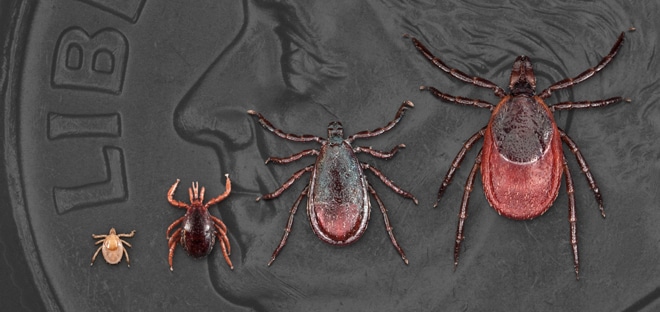Key points
- Lyme disease bacteria causing human infection in the United States are spread to people by blacklegged (Ixodes) ticks.
- In general, infected ticks must be attached for more than 24 hours to transmit infection; prompt tick removal can prevent transmission.
- Infected ticks are found most commonly in forested areas in the northeastern, north-central, and mid-Atlantic states, and in smaller areas within Pacific Coast states.

How it spreads
The bacteria that cause Lyme disease in the United States, Borrelia burgdorferi and, rarely, B. mayonii, are spread to people through the bites of infected ticks. The blacklegged tick (or deer tick, lxodes scapularis) transmits infection in the northeastern, mid-Atlantic, and north-central United States. The western blacklegged tick (lxodes pacificus) transmits infection in areas along the Pacific Coast. Lyme disease can be prevented by avoiding tick bites and promptly removing ticks.
The percentage of ticks that are infected ranges from none to over 50%, depending on the area and life stage. Blacklegged ticks found in most areas of the southeastern United States are almost never infected.

Blacklegged ticks have a 2-to-3-year life cycle. During this time, they go through four life stages: egg, larva, nymph, and adult. After the egg hatches, the larva and nymph each must take a blood meal to develop to the next life stage, and the female needs blood to produce eggs.
- Larval and nymphal ticks can become infected with Lyme disease bacteria when feeding on an infected wildlife host, usually a rodent. The bacteria are passed along to the next life stage. Nymphs or adult females can then spread the bacteria during their next blood meal.
- Female ticks infected with Lyme disease bacteria do not pass the infection to their offspring.
- Deer are a source of blood for ticks and important to tick survival and movement to new areas. However, deer are not infected with Lyme disease bacteria and do not infect ticks.

In most cases, a tick must be attached for more than 24 hours before the Lyme disease bacterium can be transmitted. If you remove a tick within 24 hours, you can greatly reduce your chances of getting Lyme disease.
In areas of the eastern United States where Lyme disease cases are common, people may be bitten by blacklegged ticks carrying bacteria from spring through the fall. From April through July, nymphs are actively questing for hosts in the environment, and in early spring and fall seasons, adults are most active. Nymphal ticks pose a particularly high risk due to their abundance and small size (about the size of a poppy seed), which makes them difficult to see. Lyme disease patients are often not even aware of a tick bite before getting sick. Adult female ticks also can transmit the bacteria but are more likely to be noticed and removed before transmission due to their larger size (about the size of sesame seed).
About other modes of transmission
- There is no credible scientific evidence that Lyme disease is spread through touching, kissing, or sexual contact. Published studies in animals do not support sexual transmission (Moody 1991; Woodrum 1999), and the biology of the Lyme disease spirochete is not compatible this route of exposure (Porcella 2001).
- Untreated Lyme disease during pregnancy can lead to infection of the placenta; spread from mother to fetus is possible but extremely rare. Fortunately, with appropriate antibiotic treatment, there is no increased risk of adverse birth outcomes. There are no published studies assessing developmental outcomes of children whose mothers acquired Lyme disease during pregnancy.
- There are no reports of Lyme disease being spread to infants through breast milk. If you are diagnosed with Lyme disease and are also breastfeeding, make sure that your doctor knows this so that he or she can prescribe an antibiotic that’s safe for use when breastfeeding.
- Although no cases of Lyme disease have been linked to blood transfusion, scientists have found that the Lyme disease bacteria can live in blood that is stored for donation. Individuals being treated for Lyme disease with an antibiotic should not donate blood. Individuals who have completed antibiotic treatment for Lyme disease may be considered as potential blood donors. Information on the current criteria for blood donation is available on the Red Cross website.
- Although dogs and cats can get Lyme disease, there is no evidence that they spread the infection directly to their owners. However, pets can bring infected ticks into your home or yard. Consider protecting your pet through the use of tick and tickborne disease prevention products for animals.
- You will not get Lyme disease from eating game meat, but in keeping with general food safety principles, always cook meat thoroughly. Note that hunting and dressing game animals may bring you into close contact with infected ticks.
- There is no credible evidence that Lyme disease bacteria can be transmitted through air, food, water, or from the bites of mosquitoes, flies, fleas, or lice.
- Lone star ticks (Amblyomma americanum), the American dog tick (Dermacentor variabilis), the Rocky Mountain wood tick (D. andersoni), and the brown dog tick (Rhipicephalus sanguineus) are not able to transmit Lyme disease bacteria, however, they can transmit bacteria, parasites, and viruses that cause other tickborne diseases.

For more information on how ticks spread disease, see: About ticks and tickborne disease.
- Porcella SF, Schwan TG, 2001. Borrelia burgdorferi and Treponema pallidum: a comparison of functional genomics, environmental adaptations, and pathogenic mechanisms.J Clin Invest 107: 651-6.
- Woodrum JE, Oliver JH, Jr., 1999. Investigation of venereal, transplacental, and contact transmission of the Lyme disease spirochete, Borrelia burgdorferi, in Syrian hamsters.J Parasitol 85: 426-30.
- Moody KD, Barthold SW, 1991. Relative infectivity of Borrelia burgdorferi in Lewis rats by various routes of inoculation.Am J Trop Med Hyg 44: 135-9.
